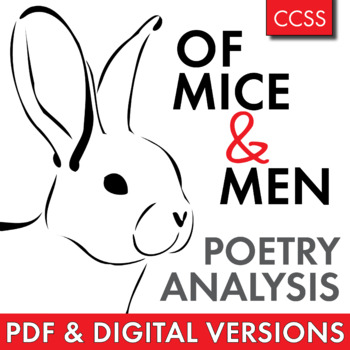"To a Mouse" Connect Robert Burns’ Poem to Steinbeck’s Of Mice and Men, CCSS
- PDF
- Google Apps™

What educators are saying
Description
“So, what does the title mean, anyway?” If you’ve ever taught Of Mice and Men, you know that you’re bound to be asked this question by the end of your unit. In this one-period Common Core-aligned lesson, introduce students to the poetry of Robert Burns as you help them make connections between the classic poem and their study of John Steinbeck’s novel, Of Mice and Men. And, yes, they’ll answer that question about the title for themselves before the class period is over.
Toward the end of our novel study, I give students a copy of the “To a Mouse” poem (Steinbeck references the great Scotman’s poem in the title of his tragic novella) and have them work in teams of two to answer the layered questions that will lead to a deep understanding of Burns, Steinbeck, and the belief about the nature of life that united these two great writers. This assignment would work just as well as a solo in-class activity or as a homework assignment with discussion on the following day.
The 2-page PDF includes a student worksheet with the public domain poem and a detailed answer key for easy grading and class discussion starters. A Google Drive version of the student handout/question set is included.
Note: This assignment uses a standard English translation of Burns’ poem, as the Scots dialect of the original proved too difficult for some of my former students to decode. Numerous versions of the original are available online. The worksheet questions apply to whichever version of the poem you prefer.
Please note that this lesson is included in my money-saving FOUR WEEK UNIT covering Steinbeck's Of Mice and Men. No need to purchase this lesson separately if you've already own the Of Mice and Men bundle.
Thanks for stopping by!
Cover image credit: Pixabay, Public domain




